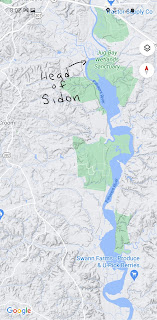River Sidon
In 1608, Captain John Smith explored the Chesapeake Bay and sailed up the Patuxent River. His claim that "Heaven and Earth never agreed better to frame a place for Man's habitation” lured many English colonist to America. (1)
Another major geographical feature that must be reconciled in the land southward is the river Sidon. We propose the Patuxent River as the river Sidon. Near the Patuxent River are hills and valleys on both the east and west side of the river, consistent with the text in the Book of Mormon and large enough to hide armies (Alma 43). One common conclusion is that the river Sidon must flow south to north because the “head” is near Manti and we know that the river Sidon also flows past Zarahemla, which is north of Manti. This is assuming “head” means the beginning of the river. Another definition of “head” found in the 1828 Noah Webster’s Dictionary is “conflux.” In the same dictionary “conflux” is defined as “a flowing together; a meeting of two or more currents of a fluid.” See also “confluence.” Finally, “confluence” is defined as “a flowing together; the meeting or junction of two or more streams of water, or other fluid; also, the place of meeting; as the confluence of the Tigris and the Frat, or of the Ohio and Mississippi.” Thus in 1828, as Joseph Smith was translating the record, the conflux of two streams of water was regarded as a “head” of the river.
The Patuxent River has such a
head at a place where the depth would be possible to cross. This head would be
less than 10 miles from where we place Manti, so an army could be placed all
the way down to Manti from the head, just as the text suggests (see Alma 43:32). These hills on the west side of the Patuxent allows for a "west valley."
The Patuxent river flows
directly into the sea afterwards. Bodies thrown into the
river can be confidently said to reach the sea and not wash up on the shore en
route, given the short distance. (see Alma 44:22).
(1). https://www.nps.gov/cajo/learn/historyculture/the-voyages.htm






Comments
Post a Comment